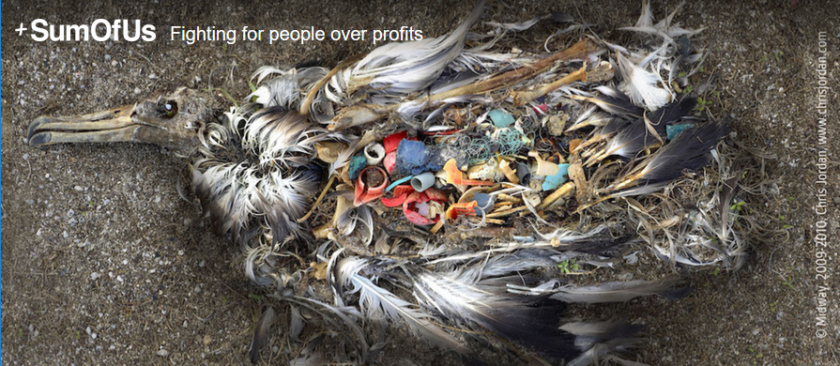
We don’t believe all too many people zap in on news channels these days. Today we’re trapped inside a tremendous media buzz diluting each source of news or fact which supplant one another by their combined magnitude, like blurring their shapes, outlines, features, rendering each one as visibly or audibly hard to discern as any particular straw in a meadow. Blocking or distracting our view and gradually leaving us unable to focus on or even discern just about anything — except that growing ethereal buzz itself. Over-consuming buzz and excessive source zapping makes us tired and often apathetic before or resistant to intriguing news or facts even at times when we’re able to actually discern them. This is a paramount reason why news or fact be concealed to so many, one way that indifference, insouciance, and soon enough ignorance goes round. This is a contributory reason for allowing Trumpeting voices to replace facts with alternatives and to win us over to their side, the dark side.
Diver’s shocking film from the tourist paradise
The British diver Rich Horner was filming during a diving tour in the waters of the Bali holiday paradise, then posted the video on YouTube, reports The Guardian.
It’s no exaggeration to claim that many viewers where shocked by what they saw.
For a few seconds you image Horner swimming around typically colorful shoals of fish in the wonderful blue tropical waters. But you quickly discover that it’s not about fish shoals, but an infinite underwater flood of plastic and other debris. The fish are gone – devastation is a fact and tourists flee Bali’s beaches.
The video was filmed at the popular Manta Point dive site on the island of Nusa Penida, twenty kilometers off Bali.
Rich Horner bdescribes what he saw as “plastic bags, plastic bottles, plastic bags, plastic cans, plastic straws, plastic bags, wrapping plastic and even more plastic, plastic and plastic”.
Bali’s got a problem with the dirty seas. Environmental problems in and around Bali have been widely observed in recent months. Every year during the rainy season, the waters around the island are flooded with debris, mainly derived from neighboring Java.
And today they do not have the resources to deal with the trash.
➽ By this post we wish to help winning those who live in darkness [back] over to the bright side which stands for enlightenment and truth, by supplying news and facts that we know are concealed to so many. However terrifying they may seem, they’re meant to open Your eyes to the necessities we must procure and provide in order to turn our astray-drifting world around and haul it to a safe harbor for repairs.
All articles supplied below aim at bringing You insight about what’s really going on, insight You may have been denied by governments’, authorities’, companies’, and some main-stream medias’ mercenary propagandist agendas — along perhaps with that buzz.
The first couple of articles disclose the horrifying situation our oceans and lakes are in when it comes to plastification. The first one discloses a tragic example among a so tragically great number of others out there, never reaching the newspaper stands. Should we at ACES ever reach our aim of providing the world with clean, cheap fuels out-competing all the fossil ones and make a handsome profit thereof, it is our solemn pledge – hereby officially announced, mark our words – that every penny we make being dispensable to the fruition of our primary business undertakings, will go to a foundation working for the deplastification of our oceans and lakes! In other words: »
» to work for a ban on non-decomposable plastic bags and other plastic packaging materials, imminently starting our own collaboration network for producing decomposable packaging and some other plastics at very competitive prices (the main thing markets do understand).
» the purge of those hundreds of millions of tons of plastic debris swirling around out there, accruing as we speak and filling the stomachs of uncountable living creatures facing a slow and painful death. And, ghoulishly enough, later when their carcass has decomposed (as distinct from plastic bags), the plastic bags trapped in their abdomen come at large once again, able to do their work as executioners over and over again, killing more and more living creatures before – if ever – “worn out”.
» the ban for nano- and micro-plastics in products like toothpaste and makeup, and for fleece fabric in clothing, blankets etc leaking micro-plastics when washed. Those chemical laden micro-plastics sicken and kill various organisms and fish in the oceans and lakes, gradually turning fresh waters into mere sewage — sewage we’ll be unable EVER to clear out.
Here are all our posts in this blog:
Water. and Air. – – – – – – – – (2016 Nov 27)
Facts. non-Alternative. – – – – – (2017 Feb 20)
News. Terrifying. – – – – – – – (2017 Mar 29)
Zero options? Never. – – – – – – (2016 Dec 05)
Scenarios. and Implications. – – – – (2017 Jan 02)
Gates Notes. on Climate-Energy. – – (2017 Jan 24)
Answers. to Questions. – – – – – (2016 Dec 14)
Testimonials. of Progress. – – – – (2017 Jul 21)
CCR – APS processes – – – – – – (2016 Dec 14)
APS/e3 concept outlines – – – – – (2016 Dec 14)
CatELab-APS/e3 research software – – (2016 Dec 14)
CatELab & APS/e3 integrated processes – (2016 Dec 14)
Here is our corporate website & our funding campaign:
Acwareus Climate-Energy Solutions – official website
Our [imminent] funding campaign (draft)
➽ April 29, 2017: 200,000 people came together for the People’s Climate March in Washington, DC, with millions more in total marching in communities around America and the world.
We sent a message loud and clear to President Donald Trump and US Congress: it’s time to stop the backsliding on climate change; it’s time to meet the most urgent challenge of our generation.
After just 100 days of a Trump Presidency, America’s leadership on climate change is melting away. Trump vowed to put America first. Instead, his climate-destruction and Polluter-first energy policies are putting America and the Whole World dead LAST.
That’s why it’s so crucial that we build on the momentum of the global People’s Climate March.
➽ So we ask you to chip in a Contribution and Back our Campaign at Indiegogo ➽ CYBEREGG — Enairgy Regeneration (draft) as soon as it launches (imminently)!
Spread the Word, Share this Blog, Share our Campaign, and Chip in a Contribution to Your Ability — Help cleaning the air making Energy from thin air. Help wave the wand of enairgee magic.
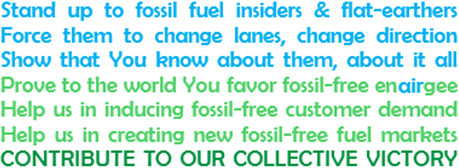
Yell Hell NO to Climate ignorance & insouciance, disregard & denial!
————————————————————————————–
—A——R——T——I——C——L——E——S—
http://www.aftonbladet.se/nyheter/nyheter/a/O5VlA/strandad-val-hade-magen-full-av-plast?ref=yfp
Stranded whale had its abdomen filled with plastic
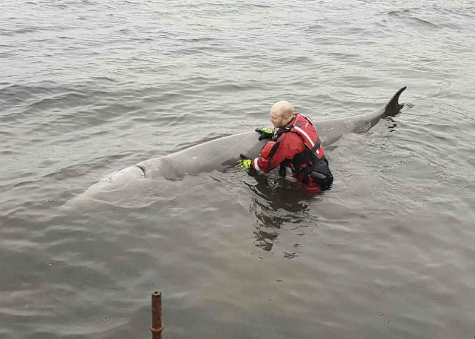
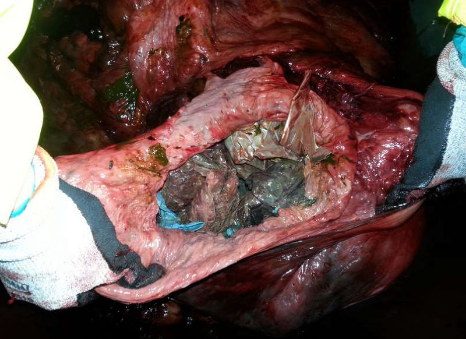
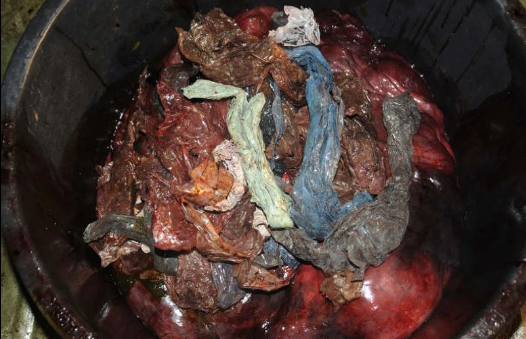

It was during the weekend that a sick Cuvier’s beaked whale stranded off Sotra, Norway. The whale was both sick and exhausted. Despite several attempts to get it out in deep water, it was soon back on shore again.
Finally it was decided that the whale would be euthanized. And in the abdomen researchers made a nasty discovery – 30 plastic bags.
– The abdomen was completely stuffed by the plastic. Around 30 plastic bags and some smaller plastics. It’s very sad, says Terje Lislevand, zoologist at the University of Bergen to NRK.
”Created a bung”
– There is no doubt. I dare not say how long it took to fill up the abdomen with plastic bags, but plastic particles has accumulated and created a blockage in the system, Lislevand says to NRK.
————————————————————————————
http://norwaytoday.info/news/sick-whale-30-plastic-bags-stomach/
Sick whale had 30 plastic bags in its stomach
Sickening Facts on Ocean Plastics / Plastic Oceans:
➽ Great Ocean Garbage Vortexes
➽ UN Declares War on Ocean Plastic
————————————————————————————
Oceans a dumping ground for up to 13 million tons of plastic every year

Between five and 13 million tons of plastic waste wind up in the world’s oceans every year, and US and Australian researchers have now warned that this amount could increase tenfold in the next decade unless the international community improves its waste management practices. The authors found the coastal countries they studied generated about 275 million tons of plastic waste in 2010, and that 4.8 to 12.7 million tons of that waste wound up in the world’s oceans.
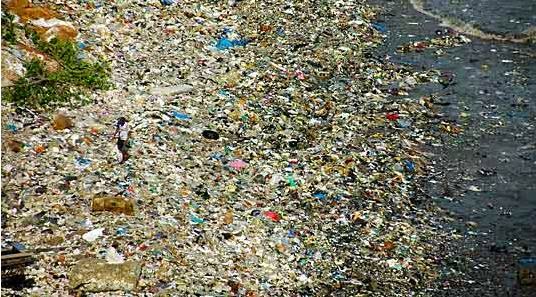
Media Release
Between five and 13 million tons of plastic waste wind up in the world’s oceans every year, and researchers warn that this amount could increase tenfold in the next decade unless the international community improves its waste management practices. Jenna Jambeck and colleagues combined data on solid waste from 192 different coastal countries with factors such as population density and economic status to reach their conclusions. They estimated the amount of plastic that moved from land to sea in 2010 and identified the major sources of this ocean-bound plastic waste, listing the 20 countries — from China to the United States — that delivered the most plastic into the oceans that year. Although many studies have highlighted the presence and location of plastic debris in the world’s oceans over the years, the amount of plastic that enters the seas annually has been unknown. Using their new model, Jambeck and the other researchers suggest that the coastal countries they studied generated about 275 million tons of plastic waste in 2010, and that 4.8 to 12.7 million tons of that waste wound up in the world’s oceans. A country’s population size, along with the quality of its waste management systems, largely determines the amount of its waste that might reach the oceans, according to the researchers. Nations around the world need to reduce waste and adopt better management strategies, such as expanded waste recovery systems, in order to prevent the amount of plastic debris in the world’s oceans from increasing by a full order of magnitude by the year 2025, they say.
————————————————————————————
https://www.pri.org/stories/2016-01-13/5-countries-dump-more-plastic-oceans-rest-world-combined
5 countries dump more plastic into the oceans than the rest of the world combined

A scavenger collects plastic for recycling in a river covered with rubbish in Jakarta, Indonesia, April 20, 2009.
The planet’s seas are choking on our junk: Soda bottles, plastic bags and tons of cigarette butts. Distant spots in the ocean — called garbage gyres — have become vortexes where humanity’s trash bobs atop the water for miles on end.
Worse yet, the filth floating on the surface accounts for only 5 percent of all the plastic trash dumped into the sea. According to Ocean Conservancy, a US environmental nonprofit, the other 95 percent is submerged beneath, where it strangles underwater creatures and wrecks the aquatic ecosystem.
It turns out that five countries are the leading contributors to this crisis. And all are in Asia.
In a recent report, Ocean Conservancy claims that China, Indonesia, the Philippines, Thailand and Vietnam are spewing out as much as 60 percent of the plastic waste that enters the world’s seas.
More from GlobalPost: Vultures with GoPros are helping clean up Peru (VIDEO)
“At this rate, we would expect nearly one ton of plastic for every three tons of fish in our oceans by 2025 — an unthinkable number with drastic economic and environmental consequences,” says Nicholas Mallos, director of Ocean Conservancy’s marine debris program.
Westerners, namely Americans, are seen as the world’s most incorrigible consumers of stuff: Soda, gadgets, sneakers and other items that produce plenty of trash. So how did a few Asian countries, many of them comparatively poor, end up churning out much of the plastic waste that swirls through the seas?
Asia is adopting Western-style appetites for consumer junk
As Asian economies rise, people have more cash to blow on Marlboros and Sprites at 7-Eleven. But the junk these habits produce often doesn’t end up in legit landfills.
In the five Asian countries listed above, only about 40 percent of garbage is properly collected. Across Asia, trash is often piled up in communal dumps where stray bits are swept up by the wind and cast into the ocean.

Indonesian fishermen on a polluted beach in Cilincing, North Jakarta, June 5, 2013.
Even sanctioned garbage dump sites are sometimes intentionally set up near rivers that flow into the sea. The reason, according to Ocean Conservancy: “Waste will intermittently be carried away by heavy rains or current, refreshing the capacity of the dump to receive more waste.”
Trash scavengers can’t keep up
Asia’s garbage pickers are the unsung heroes of conservation. They brave filth and disease to root through trash and extract plastic that can be sold to recyclers for a little cash. This ensures that lots of junk is recycled rather than abandoned in landfills.
But these pickers tend to focus on high-value items — like plastic bottles — in lieu of plastic bags, which fetch very little from recyclers.

According to Ocean Conservancy, a scavenger might spend 10 hours gathering plastic bags and take home a mere 50 cents. Devoting that day to picking up only plastic bottles, however, would rack up $3.70.
That means that scavengers skip over much of the waste, which can later end up in the sea.
Corporations crank out tiny portion sizes for the poor
A shopper in California or Texas buys shampoo by the bottle. But that’s often an unaffordable luxury to poor Indonesian or Filipino villagers, who instead buy cosmetics in mini plastic pouches.

A woman washes plastic in a river in Tianjin, China, Sept. 13, 2007.
In Asia’s rural hamlets, corporations sell everything from beauty products to instant noodles in tiny, cheap quantities. This helps even the most destitute laborers afford their wares. The result? Companies are churning out a lot more plastic packaging in poor Asian nations — and much of it winds up in the ocean.
Though corporations aren’t “making plastic with the intent of it ending up in the ocean,” Mallos says, they should be offering up their “world-class logistics, financing, project management and marketing capabilities” to help solve the problem.
Asia’s garbagemen often cut corners
In countries where the law is flimsy, garbage truck drivers will often save time and fuel by simply dumping trash by the roadside. These illegal dump sites are having devastating consequences for the seas.
In the Philippines, an island nation where sanitation trucks often flout the law, research suggests that up to 90 percent of the plastic dumped illegally ends up in the ocean. In the five Asian nations profiled by Ocean Conservancy, estimates suggest this practice adds nearly 1 million metric tons of plastic trash to the seas each year.

All that garbage is having devastating effects on the seas: choking marine life to death, dramatically warping ecosystems and wreaking environmental havoc that some experts liken to the climate change crisis.
More from GlobalPost: A quick and easy guide to the Paris climate deal
————————————————————————————
http://www.deaddonkeysfearnohyenas.com/
Video ➽ Dead Donkeys Fear No Hyenas (trailer)
Around the world, there is a massive commercial rush for farmland – the new green gold. One of the most profitable new spots for farming is Ethiopia. Hoping for export revenues, the Ethiopian government leases millions of hectares of farmland – allegedly unused land – to foreign investors. But the dream of prosperity has a dark side – the most massive forced evictions in modern history, lost livelihoods of small farmers, harsh repression ans a vicious spiral of violence. Contributing to this disaster are the EU, the World Bank and DFID (), providing billions of dollars in development money.
Dead Donkeys Fear No Hyenas investigates land grabbing – these foreign land investments – and exposes their impact on people’s lives. In the pursuing of truth, we meet investors, development bureaucrats, persecuted journalists, struggling environmentalists and evicted small farmers and their families deprived of their land.
Director’s Notes
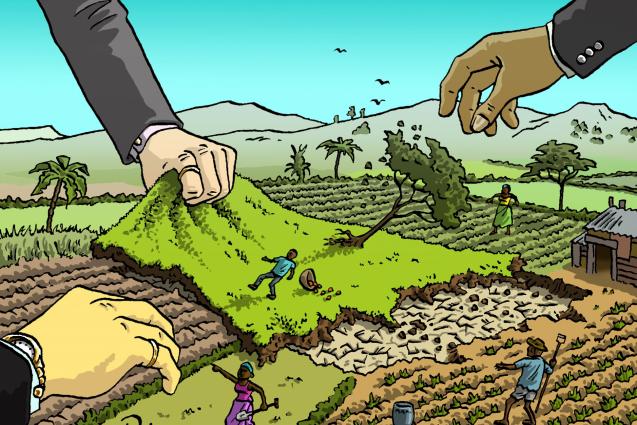
Land grabbing according to Wikipedia:
“Land grabbing is the contentious issue of large-scale land acquisitions: the buying or leasing of large pieces of land by domestic and transnational companies, governments, and individuals. While used broadly throughout history, land grabbing as used in the 21st century primarily refers to large-scale land acquisitions following the 2007-2008 world food price crisis.[1] Obtaining water resources is usually critical to the land acquisitions, so it has also led to an associated trend of water grabbing.[2] By prompting food security fears within the developed world and new found economic opportunities for agricultural investors, the food price crisis caused a dramatic spike in large-scale agricultural investments, primarily foreign, in the Global South for the purpose of industrial food and biofuels production. Although hailed by investors, economists and some developing countries as a new pathway towards agricultural development, investment in land in the 21st century has been criticized by some non-governmental organizations and commentators as having a negative impact on local communities. International law is implicated when attempting to regulate these transactions.[3]“
Read more ➽ https://en.wikipedia.org/wiki/Land_grabbing
Water grabbing or “privatization” according to Wikipedia:
“Water privatization is used here as a shorthand for private sector participation in the provision of water services and sanitation. Private sector participation in water supply and sanitation is controversial. Proponents of private sector participation argue that it has led to improvements in the efficiency and service quality of utilities. It is argued that it has increased investment and has contributed to expanded access. They cite Manila, Guayaquil in Ecuador, Bucharest, several cities in Colombia and Morocco, as well as Côte d’Ivoire and Senegal as success stories.[1][2][3] Critics however, contend that private sector participation led to tariff increases and has turned a public good into a private good. Many believe that the privatization of water is incompatible with ensuring the international human right to water. Aborted privatizations in Cochabamba, Bolivia, and Dar es-Salaam, Tanzania, as well as privately managed water systems in Jakarta and Berlin are highlighted as failures.[4][5][6][7] Water privatization in Buenos Aires, Argentina and in England is cited by both supporters and opponents, each emphasizing different aspects of these cases. Statistical studies comparing public and private utilities show little difference in performance between them.[8][9][10][11][12]
Even the figures about how many people receive water from the private sector are controversial: One source claims that 909 million people were served by “private players” in 2011 globally, up from 681 million people in 2007. This figure includes people served by publicly owned companies that have merely sourced out the financing, construction and operation of part of their assets, such as water or wastewater treatment plants, to the private sector.[13] The World Bank estimated the urban population directly served by private water operators in developing countries to be much lower at 170 million in 2007.[1] Among them only about 15 million people, all living in Chile, are served by privately owned utilities. The remainder are served by privately managed, but publicly owned companies under concession, lease and management contracts.“
Read more ➽ https://en.wikipedia.org/wiki/Water_privatization
B. Classic historic examples, to the tiny fraction we can bring forward in this post, include:
5. International mining companies’ takeover in i.a. South America = “resource grab“
——————————————————-
——————————————————-
——————————————————-
——————————————————-
(*) Early on: German Communists, Social Democrats, Roma[ni] (Gypsies), Jehovah’s Witnesses, homosexuals, and persons accused of “asocial” or socially deviant behavior. Later on: Jews, prisoners of war (British, Americans, French, Russians, Poles, “Asiatics”, …).
The lead editors of the Encyclopedia of Camps and Ghettos, 1933–1945 of the United States Holocaust Memorial Museum, Geoffrey Megargee and Martin Dean, cataloged some 42,500 Nazi ghettos and camps throughout Europe, spanning German-controlled areas from France to Russia and Germany itself, operating from 1933 to 1945. They estimate that 15 million to 20 million people died or were imprisoned in the sites. Read more on e.g. ➽ Nazi concentration camps
——————————————————-
Next 50 years will determine humanity’s outcome for “10,000 years”
Thomson Reuters Foundation March 27, 2017

REUTERS/Joe Penney
Continued use of oil, natural gas and coal at the current rate will likely raise global temperatures to 2 or 2.5 degrees Celsius above pre-industrial levels, creating conditions that would make life “difficult to manage”, said Johan Rockström.
Even more worryingly, this temperature rise may trigger natural events that would take the planet from 2 degrees Celsius to 6 degrees, which would be “catastrophic”, he said.
“What happens in the coming 50 years will certainly determine the outcome for humanity 10,000 years and beyond,” Rockström said, adding that the last 50 years of human activity has “pushed us away from the stability we’ve been in for the past 12,000 years”.
Rockström is one of a group of scientists proposing that the world halves its carbon dioxide emissions every decade from 2020, by issuing penalties on carbon emitters.
If temperatures approach 2 or 3 degrees Celsius, sea levels are likely to rise at least 7 or 8 metres (23-26 feet), and droughts and floods increase to a frequency and severity not seen before. There are also likely to be many more catastrophic weather events such as hurricanes and “massive” heat waves, he said.
Tropical areas of the earth will “very rapidly” move north, and tropical diseases will spread to other latitudes.
This temperature rise may also cause additional trigger events that will warm the planet further, he said.
These include permafrost in Siberia thawing and releasing potent greenhouse gases, forests dying and releasing carbon dioxide, and ice melting which would leave the planet with a darker surface that absorbs the sun’s heat instead of reflecting it.
“These are the kind of domino effects that we are concerned about and where we could end up in a very dangerous situation,” Rockström told the Thomson Reuters Foundation.
If temperatures rise 4 degrees Celsius or more, it will be the first time this has happened in 4 million years – since before modern humans existed, he said.
To have a chance of keeping temperature rise to well below 2 degrees Celsius, as laid out in the Paris climate agreement, countries will need to decarbonise their economies, cut emissions from agriculture and food production, and protect existing natural environments, Rockström said.
They will also need to remove carbon dioxide from the atmosphere using “geoengineering” techniques which are both costly and have not yet been tried out at scale.
But they will be a necessity, he added. “We have gone too far, we have simply emitted too much.”
BUSINESS VOICES
Too often the most vocal groups on climate are environmental non-governmental organisations and climate scientists, Rockström said.
Although their voices are important, over the decades that had led to a mistaken belief that there is a contradiction between economic growth and sustainability, he said.
“It’s very dangerous to have NGOs in the frontline, science a little behind them, because political leaders need to hear the business voice. They are the engine of growth and jobs,” he said.
One reason why the 2015 Paris climate talks were so successful was because “business was there and it was very strong”, he said.
Companies in many sectors see the potential for making money from sustainable growth, he said.
Truck companies can make vehicles that run on electricity, the aviation industry is finding ways to cut emissions, and companies in the construction industry are working on low-carbon alternatives to the current form of cement, for example.
But companies are also hedging their risks. While many are investing in new low-carbon technologies, often under the radar, they also continue to make – and sometimes lobby for – older technologies, Rockström said.
Either way, they will adapt to political realities to make the most profit in the short-term, he said.
“We’re in this Trump administration that doesn’t care about climate change at all, so (businesses in United States) basically adapt to the situation,” he said. “But if we had another administration, they would operate there to make the maximum profit.”
Overall, though, there is a general move towards sustainable economic growth, he said.
China, for example, more than doubled its solar capacity last year, making it the world’s largest producer of solar energy by capacity. It aims to generate 20 percent of its energy without fossil fuels by 2030, up from 11 percent today.
China’s rationale for shifting to clean energy is because it makes good business sense, he said.
“They are adamantly focused on their own growth, their own success and their own prosperity,” he added.
Reporting by Alex Whiting @Alexwhi, editing by Laurie Goering.
Please credit the Thomson Reuters Foundation, the charitable arm of Thomson Reuters, that covers humanitarian news, climate change, resilience, women’s rights, trafficking and property rights. Visit http://news.trust.org/climate
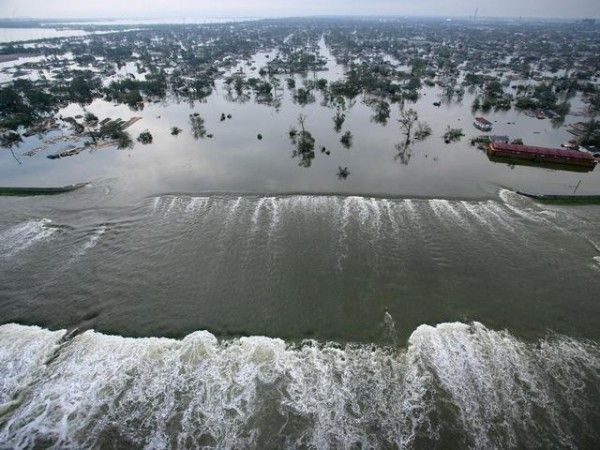 Katrina floodwaters 2005. Photo courtesy of ABC News
Katrina floodwaters 2005. Photo courtesy of ABC News
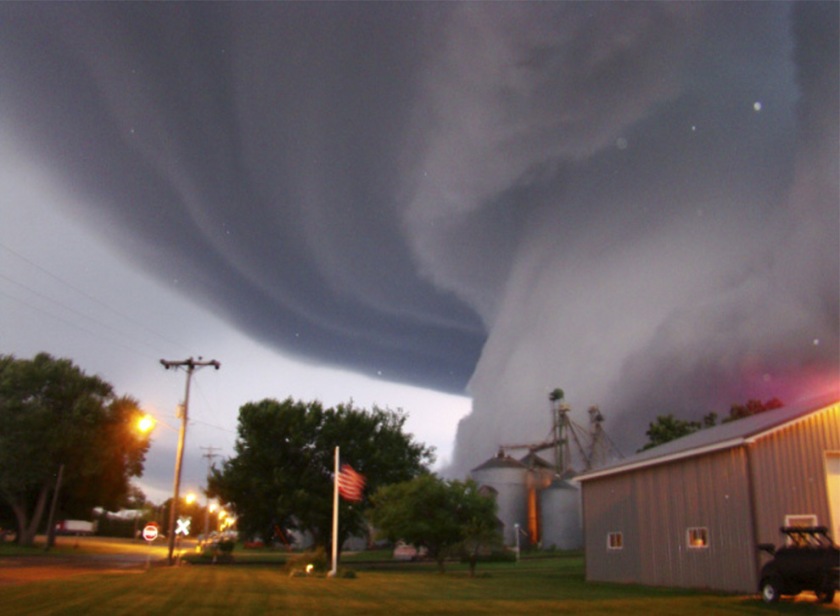
Tornado at Orchard, Iowa 2008

Mississippi flooding at Cedar Rapids, Iowa 2008
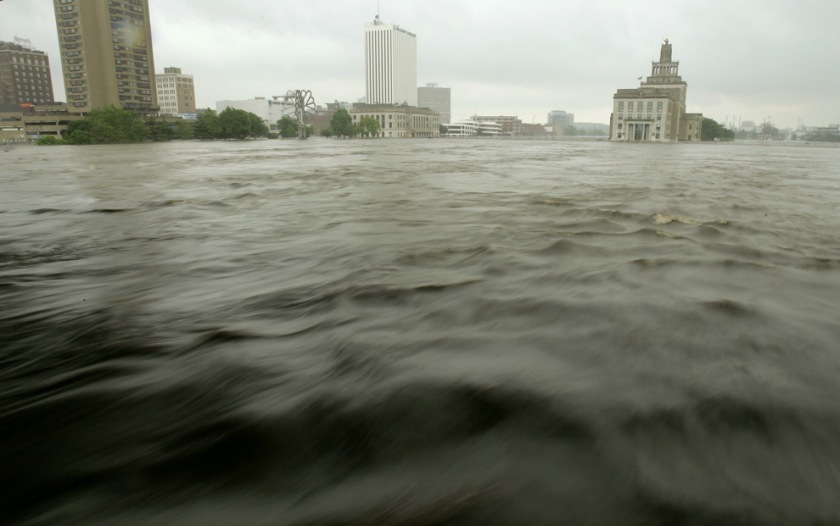
Mississippi flooding at Cedar Rapids, Iowa 2008

A is for the Arctic, Which is Melting
“I have been looking at Arctic weather patterns for 35 years and have never seen anything close to what we’ve experienced these past two winters,”
— Mark Serreze, director of the National Snow and Ice Data Center (via Quartz)
When it comes to talk about the effects of global warming a lot of focus has been on Antartica, which saw record low levels of ice this past year, but as winter in the Northern Hemisphere comes to an end all eyes are on the Arctic as the trend toward higher temperatures, low sea ice levels, and shockingly low levels of human panic and action continue.
For a bit of background, when I talk about the Arctic I am talking about the sea of ice to the north of Canada and Russia. In the summer, every summer, the ice melts as the sun becomes a constant fixture in the sky, and every winter the ice freezes again. It’s all normal and all due to Earth’s orbit, tilt, and the natural warming and cooling the seasons bring.
This winter the Arctic froze, and when scientists measured the ice at it’s largest extent, there was a whole lot missing. Average Arctic ice extent should be something like 6.04 million square miles, in March of 2017, when we take these kinds of measurements, we had 5.57 million square miles of ice. We are missing 471,000 square miles of ice! And this isn’t the first time we have been below average, and it is not going to be the last.
Less ice might not like such a big deal, except that it is. Arctic sea ice melt contributes to further and faster warming, since our bright white ice cap will be gone, it won’t reflect the sun’s rays back into space ad instead the heat will be absorbed by the ocean. Sea levels will rise, of course, and that’s bad for anyone living along the coast which is a whole lot of American citizens. Ocean and air currents will change due to the ice being gone and the temperatures being warmer. This leads to more climate change on average and more unstable weather patterns day to day.
And of course, in the end, it all boils down to more death and suffering for animals and mostly poor people who are already suffering, but it won’t end with them. We will all feel the ramifications of this.
A wise man once said “The good thing about science is that it’s true whether or not you believe in it.” and despite the fact that, yes, sea ice freezes and melts according to the seasons and yes anomalies happen and some years are freakishly colder or warmer than others the truth is that for a while now we have been trending farther and farther outside of the averages. Take a look at the terrifying graph below for example:

See that part on the right that’s clearly outside of the gray area average, that was the end of 2016, far outside even a regular bad year. See the little line on the left sitting below every other year back to 1978? That’s the beginning of 2017 continuing along on a catastrophic path toward sea level rise, ocean ecosystem disruption, and the first signs of the end times.
Now, if we remember our geometry education back in high school, we know that area and volume are different. Could it be that the ice is still there but just taking on a different shape? Nope. Take a look at this graph of bad news showing monthly global ice by volume:

See that line veering off to the right well outside the mean and below every other year as far back as 1981, that’s 2016. I haven’t seen a version with 2017 on it yet, but I would bet a lot of money that just like ice area measurements we are still trending down and still, no one is doing anything about it. Instead, we’re running around arguing about whether or not the problem is even real.
This is not normal. None of this is normal! You may hear people talk about natural cycles but take a look at another graph. This one shows measurement of atmospheric CO2 found in drilled ice cores containing bubbles of air from thousands of years ago. See that big spike on the end, well outside of anything ever, that 1950 to now. It is us! We are doing this!

Now, this is all pretty bad, but it actually gets even worse. So much worse. All hope of stopping these trends is gone. We have done too much damage. CO2 measurements will continue to rise, and the ice is going to go on melting, even if we stopped everything, all the cars, all the deforestation, all the burning, today. There is just no way, right now, that we can get the gasses we put into the atmosphere, and the ocean, back out.
We are fucked. We are so fucked and so stupid.
Scientists started warning us back in 60s that burning fossil fuels and putting greenhouse gases like CO2 and methane into the atmosphere were going to lead to a warmer Earth which would lead to collapsing ecosystems and unstable weather patterns but too many people wanted to keep on making money and fought long and hard, and are still fighting today, to keep you from panicking or changing the way you do things.
So what can you do now? Hell, why do anything if we are already too far gone?
Well, even thought the earth is going to warm and the climate is going to change, and many many people and animals are going to die, we can lessen the extent and the suffering if we start today.
The EPA has a list of things you can do today, but ost of us have read it and have made the changes that we can, but what we really need to do now is get the people who are in charge to stop being so damn selfish and stupid and do something about it. We need to contact our leaders in Congress and let them know that we will not stand for their cowardice any longer. You can even fax them by text now! There is no excuse.
Change needs to happen now if we want to have a future where humans can at least survive, and you need to ask yourself here and now, do you care? Be honest with yourself, do you want something to be done, or do you like it better when you pretend there is no consensus or science to back this up? Are you a part of the solution or part of the problem?
***
If you like this post check out my weekly-ish newsletter for interesting reads + my own existential musings on life, love, and inevitable human suffering, or buy me a cup of coffee perhaps?
This post was written for the 2017 Blogging A to Z Challenge. My theme is The World is Really an Awful Place. You can read the rest of the posts under the AtoZ2017 tag.
Featured image via Unsplash
This Antarctic glacier is cracking from the inside out — and that’s bad news for all of us
Because of rising sea levels
The glacier, which is described in a paper published yesterday in Geophysical Research Letters, is called Pine Island Glacier. In 2015, a 224-square-mile iceberg broke off from the glacier. After studying satellite images before and after the event, researchers at Ohio State University found that in 2013, a rift formed at the base of the ice shelf, 20 miles inland. The rift worked its way up for two years until it caused the iceberg to break off.
Icebergs do separate from ice sheets in the Antarctic on a fairly regular basis. This one, though, is special. It confirmed what glaciologists have long been suspecting: that the ice shelf is weakening. But it also shows that the ice retreat is happening farther inland than scientists had previously observed.
Video ➽ Ice break-off from Pine Island Glacier 2015
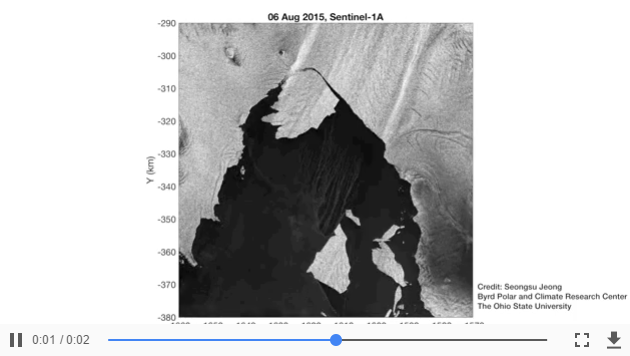
“It’s generally accepted that it’s no longer a question of whether the West Antarctic Ice Sheet will melt, it’s a question of when,” study leader Ian Howat, associate professor of Earth sciences at Ohio State, said in a statement. If things continue the way they are, glaciers will keep melting, and West Antarctica will significantly collapse “in our lifetimes.”
The Antarctic and Greenland ice sheets contain more than 99 percent of the freshwater ice on Earth. Previous papers have shown that the melting of the West Antarctic Ice Sheet is inevitable, and it could raise sea levels by as much as 10 feet. In the US, that would mean that cities like New York and Miami would go underwater.
>>> Acwareus Climate-Energy Solutions (ACES) comment: … together with tens of thousands of other coastal mega cities, towns and villages, paramount infrastructure, farming- and pasture lands, forests, water supplies, biotopes and whole ecosystems, and natural habitats to aquatic and terrestrial animals, and birds. The economical, ecological and social damages will be unmeasurable and unbearable, just as human and wildlife sufferings and death tolls, the irreversible multitudinous species extinction, millions of animal and plant species gone forever. Unless …
>>> View it all in both of these of our blog posts ➽ Zero options? Never. and ➽ Scenarios. and Implications.
Video ➽ MIAMI MAY BE UNDERWATER BY 2100
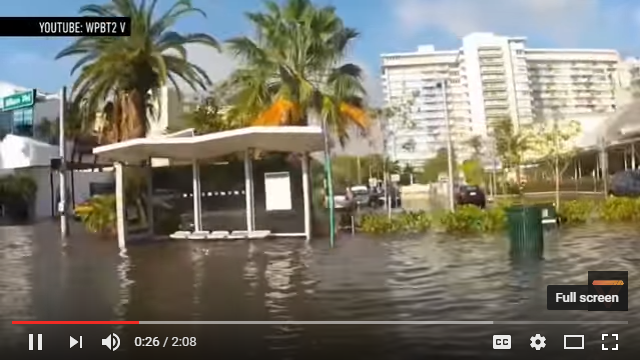
Video ➽ MIAMI BEACH DROWNING (ALREADY) — UNSTOPPABLY
(And so did New York & New Jersey in 2012, remember? — costing 65 billion USD)
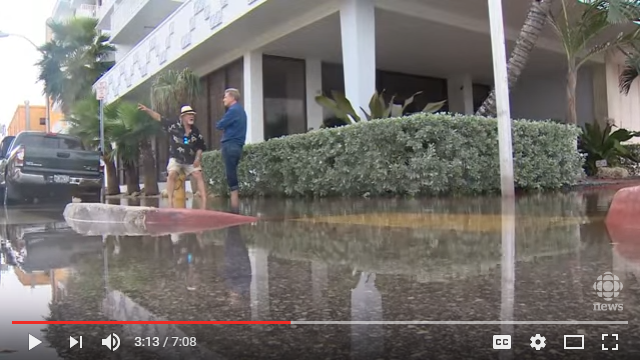
Video ➽ Hell Will Break Loose — Ice Melt, Sea Level Rise, Superstorms
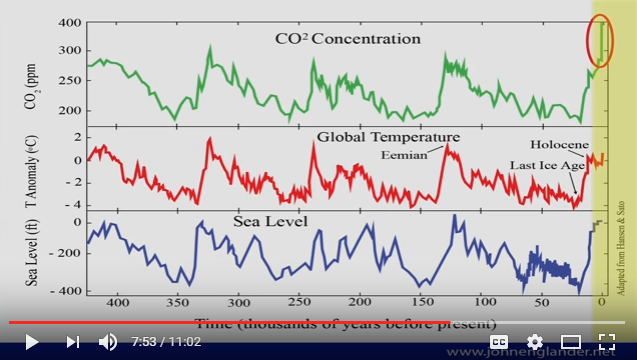
Our Future, Our Choice, YOUR Choice . . .

“We’re the first generation to feel the impact of climate change — and the last generation that can actually DO something about it” / Gov. Jay Inslee, Washington state
We humans are much rather part of a solution than part of a problem.
What about YOU ? ^_^
————————————————————————————
Sea Level Rise 
Ocean levels are getting higher. Why is this happening, and what can we do to stem the tide?

Families in Kiribati, especially those new to the island nation, are often forced to live in marginal areas, where flooding from high tides is increasing.
PHOTOGRAPH BY KENNEDY WARNE
Core samples, tide gauge readings, and, most recently, satellite measurements tell us that over the past century, the Global Mean Sea Level (GMSL) has risen by 4 to 8 inches (10 to 20 centimeters). However, the annual rate of rise over the past 20 years has been 0.13 inches (3.2 millimeters) a year, roughly twice the average speed of the preceding 80 years.
Over the past century, the burning of fossil fuels and other human and natural activities has released enormous amounts of heat-trapping gases into the atmosphere. These emissions have caused the Earth’s surface temperature to rise, and the oceans absorb about 80 percent of this additional heat.
The rise in sea levels is linked to three primary factors, all induced by this ongoing global climate change:

- Thermal Expansion: When water heats up, it expands. About half of the past century’s rise in sea level is attributable to warmer oceans simply occupying more space.
- Melting Glaciers and Polar Ice Caps: Large ice formations, like glaciers and the polar ice caps, naturally melt back a bit each summer. In the winter, snows, primarily from evaporated seawater, are generally sufficient to balance out the melting. Recently, though, persistently higher temperatures caused by global warming have led to greater-than-average summer melting as well as diminished snowfall due to later winters and earlier springs. This imbalance results in a significant net gain in the ratio of runoff to ocean evaporation, causing sea levels to rise.
- Ice Loss from Greenland and West Antarctica: As with the glaciers and ice caps, increased heat is causing the massive ice sheets that cover Greenland and Antarctica to melt at an accelerated pace. Scientists also believe meltwater from above and seawater from below is seeping beneath Greenland’s and West Antarctica’s ice sheets, effectively lubricating ice streams and causing them to move more quickly into the sea. Higher sea temperatures are causing the massive ice shelves that extend out from Antarctica to melt from below, weaken, and break off.
CONSEQUENCES
When sea levels rise rapidly, as they have been doing, even a small increase can have devastating effects on coastal habitats. As seawater reaches farther inland, it can cause destructive erosion, wetland flooding, aquifer and agricultural soil contamination, and lost habitat for fish, birds, and plants.
When large storms hit land, higher sea levels mean bigger, more powerful storm surgesthat can strip away everything in their path.
In addition, hundreds of millions of people live in areas that will become increasingly vulnerable to flooding. Higher sea levels would force them to abandon their homes and relocate. Low-lying islands could be submerged completely.
HOW HIGH WILL IT GO?
Most predictions say the warming of the planet will continue and is likely to accelerate. Oceans will likely continue to rise as well, but predicting the degree to which they will rise is an inexact science. The Intergovernmental Panel on Climate Change says we can expect the oceans to rise between 11 and 38 inches (28 to 98 centimeters) by 2100, enough to swamp many of the cities along the U.S. East Coast. More dire estimates, including a complete meltdown of the Greenland ice sheet, place sea level rise to 23 feet (7 meters), enough to submerge London.
————————————————————————————
This Disastrous Trend Is Snowballing and It’s Ripping Away Our Food Choices
April 01, 2017.
Video ➽ Open Sesame – The Story of Seeds
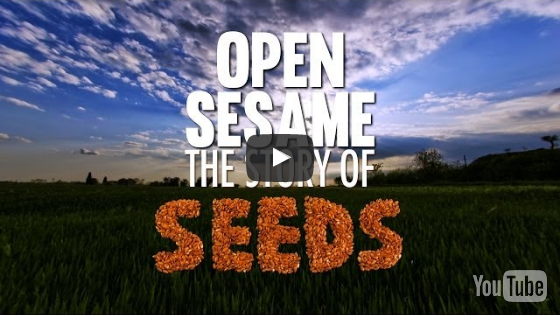
The seed saving movement is growing. Communities are banding together to save and share heirloom and open pollination seeds that are in danger of disappearing off the face of the Earth as a result of industrialized agriculture and multinational corporations that control the majority of our seed supply.
The documentary “Open Sesame: The Story of Seeds,” by M. Sean Kaminsky seeks to inspire people about the importance of seed saving — and its urgency.1
When you save seeds, you’re joining a chain of farmers, gardeners and seed enthusiasts that dates back to the Stone Age — our civilization literally arose due to seed saving.
Early humans selected the best wild plants with which to feed themselves, and passed those varieties along to others by saving and sharing seeds.
Seeds are the foundation of life, from fruits and vegetables to grain and livestock feed — without them, we have no food. It’s estimated that upward of 90 percent of our caloric intake directly or indirectly comes from seeds.
Age-old heirloom varieties are disappearing at an alarming rate — 90 percent of the crop varieties grown 100 years ago are already gone. The Millennium Seed Bank Partnership estimates that 60,000 to 100,000 plant species are in danger of extinction.2
Why Seed Saving Is So Important
Four of the most important reasons to save seeds are the following:3
1. Seed Security: By saving your seeds, you control your seed and therefore your food supply — you aren’t depending on seed stores or catalogs for difficult to find seed.
Hundreds of excellent plant varieties have been discontinued as big corporations have consolidated the seed industry and focused on more profitable varieties. Half of the vegetables grown today have no commercial sources — you have to get them through seed trades.4
2.Regional Adaptation: Most commercially available seed has been selected because it performs fairly well across the entire country if given synthetic fertilizers.
But when you save seed from your own best performing plants, on your land and in your own ecosystem, you gradually develop varieties better adapted to your own soil, climate and growing conditions.
3.Consistent Quality: Large seed suppliers rarely “rogue” the fields to pull out inferior or off-type plants, so the open-pollinated (OP) seeds they sell have inferior specimens in the mix.
You can select your own seed for uniformity and quality. You can control the gene pool for optimal germination, ripening time, flavor, storage, disease resistance and color. After a few seasons, more and more of your plants will have all of your personally selected traits.
4.Preserving Your Heritage and Biodiversity: Today multinational corporations select seed varieties according to their own financial interests; they control 82 percent of the world’s seed market, which includes 75 percent of the vegetable seed market.
It’s up to small farmers and home gardeners to preserve thousands of years of biodiversity.
Understanding Open-Pollinated, Heirloom and Hybrid Seeds
As a gardener, one of your more important decisions is whether to choose open-pollinated, hybrid or heirloom seed varieties — but which are best?
According to Seed Savers,5 for seed saving purposes, the most significant distinction among these types is saving true-to-type seed from open-pollinated and heirloom varieties, and avoiding hybrids.
Open-pollination seeds are pollinated by insects, birds, humans, wind or other natural mechanisms. According to Seed Savers:6
“Because there are no restrictions on the flow of pollen between individuals, open-pollinated plants are more genetically diverse. This can cause a greater amount of variation within plant populations, which allows plants to slowly adapt to local growing conditions and climate year-to-year.
As long as pollen is not shared between different varieties within the same species, then the seed produced will remain true-to-type, year after year.”
An heirloom variety is a plant that has a history of being passed down multiple generations within a family or a community. An heirloom variety is by definition open-pollinated, but not all open-pollinated plants are heirlooms.
Hybridization is a controlled method of pollination in which the pollen of two different species or varieties is crossed (usually by human intervention, although it can happen in nature), usually from a desire to breed in a particular trait.
Hybrids are typically unstable and less vigorous, producing fewer of those desirable traits with each passing year. However, hybrid seeds can be stabilized by open-pollination — by growing, selecting and saving the seeds over many seasons.
Choosing open-pollinated and heirloom seeds helps conserve genetic diversity and prevents the loss of unique varieties, including the ones that contribute to our long-term survival because of special hardiness and disease-resistance traits.
Biodiversity is our only insurance in times of vulnerability, such as when facing climate change.
Our Loss of Seed Diversity Is Shocking
In 80 years (between 1903 and 1983), we lost 93 percent of the variety in our food seeds. According to Rural Advancement Foundation International:7
- We went from 497 varieties of lettuce to 36
- We went from 288 varieties of beets to 17
- We went from 307 varieties of sweet corn to 12
Even the popular heirloom tomato has taken an enormous hit, having lost at least 80 percent of its diversity over the last century. Even more tragic is the fact that a lot of these precious plants are being replaced by patented genetically engineered (GE) varieties.
The National Geographic infographic below shows how many varieties of fruits and vegetables appear to be nearing extinction.8 This data is already more than 30 years old, so the statistics may be even more grim today.
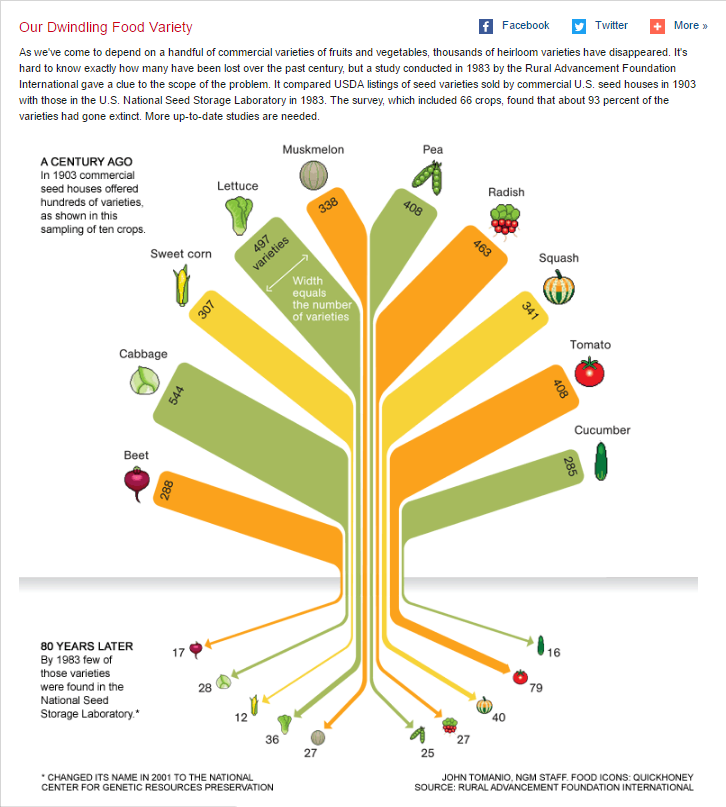
The Disastrous Consequences of Patenting Life
Traditionally, seeds have been saved and shared between farmers from one season to the next. Farmers rarely ever had to buy new seed. Nature, when left alone, provides you with the means to propagate the next harvest in a never-ending cycle. Valuable heirlooms have been replaced by massive expanses of genetically engineered (GE) crops. According to the USDA, 94 percent of U.S. soy and 88 percent of U.S. corn are now genetically engineered (GE).
It’s estimated that, since 1970, 20,000 seed companies have been swallowed up by mega-corporations. In 2005, Monsanto bought the world’s largest fruit and vegetable seed company, Seminis, for $1.4 billion. Just four agrichemical companies now own 43 percent of the world’s commercial seed supply, and 10 multinational corporations hold 65 percent of global commercial seed for major crops.9
Many farmers are now dependent on patented GE seeds and must buy them every year from companies like Monsanto. Saving such seeds is illegal because it’s considered patent infringement.
Farmers don’t buy seed anymore — they essentially buy a license to use the seed for a short period of time — typically one season. It’s more of a lease, or a “technology use agreement.” For 200 years, the patenting of life was prohibited, especially with respect to foods. But all of that changed in 1978 with the first patent of a living organism, an oil-eating microbe, which opened the proverbial floodgates.
According to the film, one of Monsanto’s proxies has a patent claiming 463,173 separate plant genes! Patenting of life forms was never approved by Congress or the American public, but as far as the GMO industry is concerned, they own a gene wherever it ends up and however it gets there. The trail of destruction left by GE seeds isn’t limited to the West — Indian farmers have been coerced into using them, with completely disastrous consequences.
GE Seeds Responsible for 250,000 Farmer Suicides
More than a quarter of a million Indian farmers have committed suicide over the past 16 years, since the introduction of GE seed. These crops have failed (especially Bt cotton), leaving them financially ruined. Bt cotton is much more expensive than traditional cotton seed, requires more water and pesticides, and has failed to produce the increased crop yields promised by Monsanto.
India’s government has largely abandoned small farmers, discontinuing support programs and failing to address factors such as lack of rural credit and access to irrigation, among others, and new government programs have barely scratched the surface of this crisis, which results in one farmer committing suicide every 30 minutes, typically by ingesting pesticides like Roundup.
On a side note, concerns over glyphosate’s toxicity are finally starting to be taken seriously. The U.S. EPA announced in 201510that U.S. regulators may start testing for glyphosate residues on food in the near future, but only a year later, in November 2016, the FDA announced that it was putting its testing “on hold” even though the International Agency for Research on Cancer determined that the active ingredient in Roundup is a “probable carcinogen.”
While thousands of foods are tested for about 400 different pesticides each year, glyphosate is not on that list simply because it’s been thought to be safe. A step in the right direction, however, is that in early 2017 a California court ruled that the state’s efforts to require warning labels about the cancer possibility could move forward.
While that’s good news, it’s worth noting that the EPA raised the allowable limits for glyphosate in food in 2013, and the allowable levels may be too high to protect human health, based on mounting research. Root and tuber vegetables (with the exception of sugar) got one of the largest boosts, with allowable residue limits being raised from 0.2 ppm to 6.0 ppm.
Meanwhile, malformations in frog and chicken embryos have been documented at 2.03 ppm of glyphosate.11 And, as reported by the Institute for Science in Society:12
“The amount of allowable glyphosate in oilseed crops (except for canola and soy) went up from 20 ppm to 40 ppm, 100,000 times the amount needed to induce breast cancer cells.”
Video ➽ The Twisted Truth About GMOs
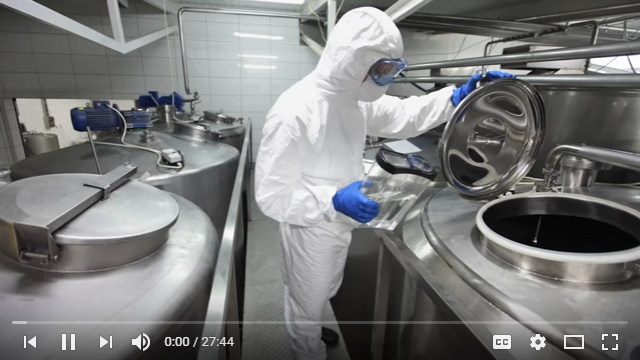
Click HERE to watch the full interview! (1:18:03)
Genetically modified organisms (GMOs) are a serious threat to our environment and our health. Although the U.S. has the strictest food safety laws in the world governing new additives, the FDA has allowed GMOs to evade those laws, as Steven Druker explains in this recent interview.
The sole purported legal basis for the marketing of GE foods in the U.S. is the FDA’s claim that they’re “Generally Recognized as Safe” (GRAS) — a claim that is actually fraudulent. Documents released as a result of a lawsuit against the FDA reveal that the agency’s scientists warned superiors about the extraordinary risks of GE foods — but their warnings were spurned and covered up.
According to the law, no GE food can qualify as GRAS unless there is overwhelming consensus about its safety within the scientific community, and that consensus cannot be based on hypotheses or speculation — it must be based on solid evidence. In the case of GE foods, there is no such evidence. FDA’s own files contain the admission that they didn’t have any technical evidence upon which to base their presumption that GE foods are GRAS.
On January 24, 2015, a statement signed by 300 scientists was published in a peer-reviewed journal,13 asserting that there is no scientific consensus about the safety of GE foods, which confirms that they are on the U.S. market illegally.
The American Academy of Environmental Medicine wrote, “There is more than a casual association between GE foods and adverse health effects.” They go on to cite specific scientific evidence pointing to potential organ damage from GE foods (liver, kidney, spleen and GI system), accelerated aging, immune dysregulation, infertility … and the list goes on and on.14
Support Seed Diversity by Ditching GE Food
As you often hear me say, one of your greatest powers is your pocketbook. You can take back control over our food supply with the choices you make about the foods you eat, the seeds you plant, and the products you use. Here are a few suggestions:
- Stop buying non-organic processed foods. Instead, build your diet around whole, unprocessed foods, especially raw fruits and vegetables, and healthy fats from coconut oil, avocados, organic pastured meat, dairy and eggs, and raw nuts
- Buy most of your foods from your local farmers markets and organic farms
- Cook most or all your meals at home using whole, organic ingredients
- Frequent restaurants that serve organic, cooked-from-scratch local food. Many restaurants, especially chain restaurants, use processed foods for their meals (Chipotlé is a rare exception)
- Buy only organic, open-pollinated and heirloom seeds for your garden, which applies to both decorative plants and edibles; they’re obtainable from seed swaps, seed libraries and exchanges (see next section for sources)
- Boycott all lawn and garden chemicals (fertilizers, pesticides, herbicides) unless they are “OMRI Approved,” which means they’re allowed in organic production. If you use a lawn service, make sure they’re using OMRI Approved products as well
- Join the Organic Consumers Association’s new campaign, “Buy Organic Brands that Support Your Right to Know”
Seed Saving Resources
If you want to begin saving your own seeds, there are four basic steps: Choosing the right plants, collecting their seeds, cleaning the seeds and storing them appropriately.15 Below are some excellent seed saving resources, as well as suggestions for where to purchase open-pollinated and heirloom seeds.
- “Seed to Seed: Seed Saving Techniques for Vegetable Gardeners,” by Suzanne Ashworth (March 2002) is an excellent and widely cited book about seed saving
- Organic Seed Growers and Trade Association (OSGATA): National non-profit organization committed to protecting, promoting and developing the organic seed trade and its growers
- Seed Savers Exchange: Organization whose mission is to promote saving and sharing of heirloom seeds and plants
- SeedSave.org: Online seed school with free downloadable book about the basics of seed saving
- Hudson Valley Seed Library: Featured in the movie, Hudson is much more than a library — it’s also a place where you can order heirloom seed
- Mother Earth News articles16 about their picks for the top 15 vegetable seed companies
Why Independent Films Are So Important
Cinema plays an important role in how we think, how our opinions are formed, and how we view our ever-changing world. Independent film makers take huge risks and are often the main financial support behind bringing you cutting edge and riveting news through the eyes of experts and real life survivors.
They are not swayed by cinema or popular opinion, but are instead influenced by their dynamic surroundings and the evolution of change to bring you the facts at their own cost. We need independent film makers to continue to bring us the news that no one else is willing to face. Please show your support for these amazing artists for their hard work and efforts to bring us the facts by visiting their sites, sharing their information and purchasing their films.
I believe in bringing quality to my readers, which is why I wanted to share some information about the producer, Sean Kaminsky, of Open Sesame. Through his hard work and dedication we are able to shine a light on the dangers and poisons that are hiding in our food and damaging our health. Thank you to Mr. Kaminsky for sharing with us.
 About the Director I believe in bringing quality to my readers, which is why I wanted to share some information about the director, Sean Kaminsky, from “Open Sesame: The Story of Seeds.” We sat down with Sean to learn a little more about what goes in to making these films. Thank you to Sean for sharing with us. What was your inspiration for making this film? When I told friends I wanted to make a short documentary about seeds back in 2009, I received lots of blank looks and polite nods. Many folks (myself included) were pretty disconnected from the source of our food. And back then I didn’t have a garden. That only came after the film! “Open Sesame” quickly grew into a full-length feature after I started to interview people and learned what was at stake. I’d already worked on several environmentally themed projects including an HBO documentary on climate change and numerous shorts for Sundance Channel. I felt like I had a decent grasp of the primary environmental issues we faced. So, I was stunned to learn about the seed crisis — but when I started the film few people were talking about the importance of seeds or how industrial farming, patents and GMOs threaten 12,000 years of our agricultural heritage. All those blank looks told me I was on the right track in telling a story that needed to get told. What was your favorite part of making this film? Making this film was an incredible adventure and it’s hard to choose one favorite. One favorite part was meeting numerous amazing individuals who have tremendous passion for seeds and want to help change our food system. Many of the people that I filmed with have since become friends. I feel grateful to have been able to share their stories. Visiting Navdanya in India was an incredible experience and witnessing the love and care they gave seeds was something I worked hard to convey in the film. Seed School was also a highlight since I learned a ton while shooting and still use many of the tips I learned in my own small garden when I plant. The editing process was also rewarding because that’s when I started to discover the threads that unite folks in the growing community seed movement. Amidst all the challenges, there are reasons for hope and optimism. Where do the proceeds to your film go? This film has been a passion project from start to finish without support from big media companies or distributors. Everyone who supports the film also supports sustainable indie filmmaking. A significant percentage of proceeds goes toward outreach and helping to make the film affordable for small community screenings. I also have another food-related film in the early stages of production. There are many challenges facing our food supply and more stories that need to be told!  |
Discover the Truth About GMO Foods – Get The Ultimate Guide to GMOs eBook for Free!
Due to the prevalence of GMO foods in the food industry, Dr. Mercola shares everything you need to know about these deceptive foods in his free eBook, The Ultimate Guide to GMOs.
Spare Yourself from Being Fooled by GMO Foods – Learn the Truth Behind GM Crops
With the advent of technology, scientists are continuously discovering methods to advance our food system. They’ve come up with outrageous ways of altering our food supply, and one of those is through the invention of GMO foods.
As the curiosity and concern of many people grow, they are now starting to ask: what is a GMO food?
GMO foods or genetically modified organisms are produced from the unusual combination and alteration of any organism’s genetic components. Once the seeds of any crop have been genetically engineered or modified, it promises to make every farmer’s dream to come true.
The big biotech companies that produce GMOs guarantee that GM crops or seeds will result in abundant harvest and less use of pesticides and herbicides. They also said that foods produced from GMO crops are generally safe and can sustain global food supply.
But do GMOs live up to their promise? Are GMO foods really the answer to solving hunger around the world?
Find out the truth and repercussions brought by GMOs in our food industry with my free eBook, The Ultimate Guide to GMOs. In it, I will share to you my discoveries about the dangers lurking behind the use of GM crops.
Are You Serving Genetically Modified Foods to Your Family?
If you’re a complacent shopper, you might be picking whatever food is on the grocery shelf. You might be perfectly satisfied that the food industry is giving you the food, thinking that it’s got your best interests in mind.
But you’re certainly wrong – all they have in mind is how much profit genetically modified foods will bring into their pockets.
Some of the most cultivated GM crops today include:
- GM corn. Monsanto’s Bt corn produces its own pesticide that kills insects. About 85 percent of corns planted in the country are genetically modified.
- GM soybean. It is estimated that 91 percent of soybeans currently available are genetically engineered.
- GM cotton. About 88 percent of the cotton industry has been genetically engineered to produce its own pesticide.
Aside from these, there are many other crops and seeds that are genetically engineered. And you might be purchasing them unknowingly. Learn more about them in my latest eBook, The Ultimate Guide to GMOs, where I reveal various genetically modified foods that you must veer away from.
Support GMO Labeling and Know What You Are Eating
More than 80 percent of processed foods today contain genetically engineered ingredients. Despite the fact that genetically modified foods are now widely prevalent in the food industry, consumers like you can still do something to change its course by carefully choosing and buying organic foods.
That’s what GMO labeling is all about. GMO labeling aims to give you the freedom to choose the food you’re buying. It is very important that consumers are given the right to know if the food they’re purchasing contains genetically engineered ingredients.
However, there are many forces who greatly oppose GMO labeling — giant food and biotech businesses that are willing to shell out huge amounts of cash just to continue and ensure that they still reign over the grocery shelves. Read my FREE eBook, The Ultimate Guide to GMOs, and you will be surprised to know who are the companies who are willing to put you at risk in exchange for profits.
Educate yourself and your loved ones on the nitty-gritty about GMOs. Discover which foods are truly healthy for you and get rid of the ones that are slowly destroying your body. Read this eBook today!
————————————————————————————
How the FDA Supports Big Food Companies in Selling More Junk Food
Video Transcript: How the FDA Supports Big Food Companies in Selling More Junk Food
Ty Bollinger: I’m here with Rob Verkerk with the Alliance for National Health International [ANH]. Rob, thank you for being with us tonight.
Dr. Robert Verkerk: Hey, it’s fantastic to be with you too.
Ty Bollinger: And what I want to do is get you, first of all, to tell our listeners exactly who you are and what you’re doing with the ANH and then I’ve got a couple other questions for you. So first of all, just kind of give us a background on you.
Dr. Robert Verkerk: ANH is all about working very hard to protect sovereignty over our bodies in order to be able to manage our health, have freedom of choice, ensure that there is informed choice to make those choices, and allow people to manage their health in the way that we have already been doing for many hundreds of thousands of years.
And of course, modern science comes along now and, coupled with what we already know from traditional systems, most of the solutions to most of the big diseases that are out there that are creating a huge burden on healthcare systems around the world, the information is available.
But it’s not getting to people. There’s a whole regulatory movement that is being developed by very large corporations in cahoots with governments, that is increasingly impinging our ability to choose products that can really transform lives, transform the quality of lives, and eliminate the burden of disease that is really crippling society today.
Ty Bollinger: So you mentioned regulatory agencies. Now here in the United States we think of the FDA. But you’re working with ANH International. Is the FDA the only regulatory agency that we need to worry about?
Dr. Robert Verkerk: Not at all. The FDA exists in different forms in all other countries.
In some cases you have authorities like the FDA that deal both with food and with drugs. In other parts of the world you’ve got specific food authorities and other drug authorities that are somewhat separated.
The difficulty when you have the same people dealing both with food and drugs or sharing offices within similar buildings, is that they inevitably develop a system of regulation that works for the corporations that supply the largest amount of money to those governments.
These people are bureaucrats so they’re not necessarily looking at the big picture. They’re certainly not looking at how they can resolve the disease burden in any particular country or part of the world. And the system, the intricate system that is being developed by these authorities working globally, these groups and bureaucrats working globally is already being mapped out.
If we look say at the development over the last 40 years of the Codex Alimentarius, this is how corporations and governments have come together in order to manage the global food trade.
The increasing availability of processed foods, or preserved foods, or foods that have been irradiated, or that have relatively high levels of pesticide residues − all of that has been agreed at an international level through Codex.
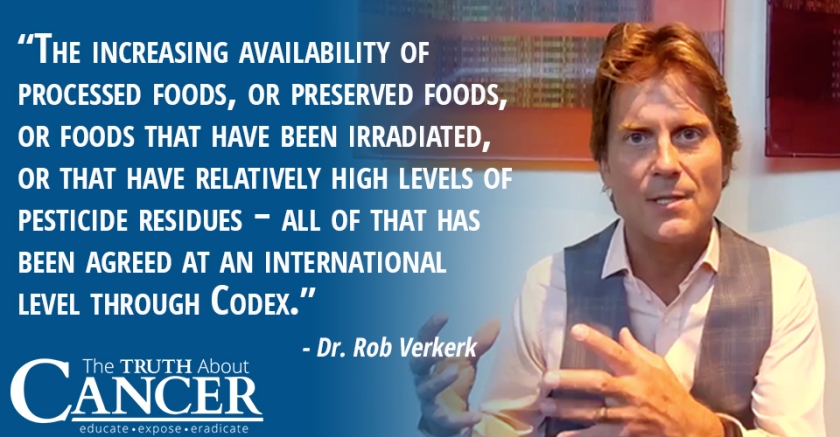
And it has been 100 percent supported by the FDA and also by the European Commission that interestingly stands as a body that represents the trading block of the 28 member states that comprises Europe. Which actually supports now our population of close to half a billion people.
And again, in this system at Codex there is a consensus approach to decision making and there are a number of countries such as the USA, Canada, Europe, and Australia, and even New Zealand that play a dominant role. If a smaller country, say a sub-Saharan African nation disagrees with any of these issues they tend to be quashed.
As a result you get a system of trade that is meant to be all about free trade, but it’s actually expanding trade in products that — particularly food products — that are right at the nub of the key health problems that we have.
So if we look at the prevalence of American-style foods that are maybe typified by say McDonald’s or other processed foods. Or the products of Pepsi, for example, or Coca-Cola, of which there are many associated products, or products from Nestle that cover many, many different brands… these are the companies that play the dominant roleso that their products can be available in more or less the same form in supermarkets all over the world.
Want to be notified when other awesome interviews or articles are added? Click here for our free weekly digest. You’ll be glad you did.

If Cancer Scares You, Do Not Miss This…
See the Truth About Cancer here.
Over 20,000 people die each day from cancer. So if it scares you, that’s understandable.
However… whether you’re trying to avoid cancer or beat it if you’ve got it, there is one very powerful antidote to the fear, and to the disease itself: knowledge.
In “The Truth About Cancer: A Global Quest” you’ll discover the most powerful ways to prevent, treat, heal from, and beat the disease. Though you haven’t heard of most of these ways, you deserve to, so…
Click here now to conquer the fear, and find out what you really need to know.
————————————————————————————
Documentary Sheds Light on Toxic Household Products
April 08, 2017
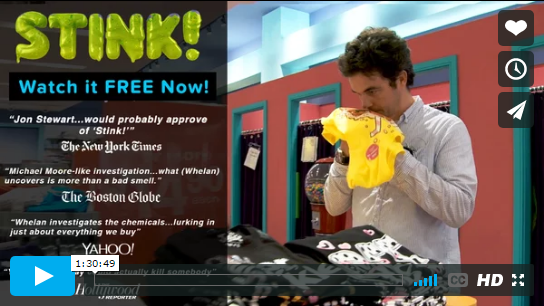
Story at-a-glance
- U.S. manufacturers of baby-care, household and personal care products are not required to fully disclose toxic ingredients, even if those ingredients could be hazardous to your health
- The word “fragrance” is a catch-all term that refers not to a single ingredient but rather one or more of nearly 3,000 synthetic chemicals that may damage your health
- U.S. trade organizations, such as the American Chemistry Council, spend hundreds of millions of dollars annually to aggressively back manufacturers in a joint effort to conceal toxic ingredients
A family-oriented documentary called “Stink!”1 shines a bright light on the unregulated use of toxic chemicals in U.S. consumer products, from baby wipes and shampoo to floor cleaners and laundry detergents.
The idea for the film originated from director Jon Whelan’s experience in tracking down the source of a strong chemical odor that wafted off new pajamas he’d purchased for his two young daughters.
After discovering the toxic stench was a trade secret held by the parent company of popular American tween store Justice, Whelan began investigating the fragrance industry, which he suggests is valued at $100 billion.
What Whelan found is that manufacturers, with the aggressive backing of the chemical industry, routinely conceal thousands of potentially toxic ingredients in the baby care, household and personal care products you and your family use every day.
They do so by using the term “fragrance,” which is entirely free of government oversight and safety regulations.2
Lack of regulation means that when you see the word fragrance on product labels, it does not refer to a single ingredient, but likely dozens of toxic chemicals in combination.
For example, S.C. Johnson’s fresh citrus blossom-scented Glade PlugIns oil refill contains a whopping 60 chemical components, which are encompassed under a single word on the product label: fragrance.
According to the Geneva-based International Fragrance Association (IFRA), the self-regulating body of the global fragrance industry, about 3,000 specific chemicals fall under the term fragrance.3
When you purchase a product that lists fragrance as one of the ingredients, you have no way of knowing how many chemicals reside within, or how those chemicals might interact with each other. Many of the chemicals are synthetic — often petroleum based — and increasingly linked to chronic health conditions.
Safety and Regulation of US Consumer Goods Is Weak
You may be surprised to know that legislation put in place in the U.S. in 1976 — a measure called the Toxic Substances Control Act (TSCA) — has perhaps done more harm than good in terms of regulating the chemicals used in products that you use daily.
Notably, TSCA grandfathered in some 80,000 chemicals that are ready available and can be easily incorporated into all kinds of consumer products manufactured and sold in the U.S.
As such, these chemicals bypass safety testing and remain free of federal government regulation and oversight. Stacy Malkan, co-founder of the Campaign for Safe Cosmetics comments:4
“The chemical industry has gotten away with producing billions of tons of chemicals without doing safety studies, putting them out into the environment … and into products that are … in our homes. Basically we are living in a ‘toxic soup,’ and it’s a giant experiment on human health.”
It may surprise you to learn that U.S. regulatory agencies such as the Consumer Products Safety Commission, Environmental Protection Agency (EPA) and Food and Drug Administration have limited authority to regulate manufacturers who add toxic ingredients to their products.
“I think that most people’s perception is that somewhere, someone is testing all the products,” says Whelan.5 But, they’re not.
This lack of oversight allows manufacturers of baby-care, household and personal-care products — with the support of powerful and well-funded trade associations — to add thousands of toxic chemicals to products you use every day. Whelan states:
“The American Chemistry Council is the most powerful trade association anywhere, and it spends hundreds of millions of dollars to influence public opinion, fund political campaigns and underwrite aggressive lobbying efforts.
Their goal is to avoid regulation that would impact profits of the largest chemical companies in the world, such as BASF, ConAgra Foods, Dow, DuPont, General Mills, Monsanto, Nestle, Pepsico and Unilever.”
Due to the tremendous amount of chemicals coming at you from multiple sources, some of the fragrances that you are exposed to daily may be damaging your health and putting you at risk for serious illness.
The ‘Fragrance Loophole’ and Why Should It Concern You
Jane Houlihan, vice president of research for the Environmental Working Group (EWG), notes that the lack of U.S. government oversight with respect to added chemicals in consumer products is referred to as the “fragrance loophole:”6
“One big loophole in the labeling law is “fragrance.” Manufacturers don’t have to list their ingredients. So whether you hold a perfume, cologne, shampoo or shaving cream — whatever the product is — normally the fragrance components aren’t disclosed.
There can literally be a mixture of hundreds of different chemicals hidden in that one ingredient.”
Adds Green Living Expert Alexandra Zissu, “You’re eating fragrance, wearing fragrance, washing your hands with fragrance and even blowing your nose with fragrance.”7
Among the undisclosed ingredients are several known or suspected allergens, carcinogens, endocrine disruptors, environmental pollutants, neurotoxic chemicals and respiratory irritants.
Because these toxins are responsible for the spike in chronic diseases from asthma and birth defects to infertility and cancer, “The sooner you get this stuff out of your life, the better,” says Zissu.8
Worse, due to the lack of product testing and safety measures, the interaction of fragrance chemicals across multiple products cannot be known. No one stops to ask what kind of interaction might take place when chemicals from your body spray interact with your acne cream.
By the way, did you know the average American female uses up to 20 products, and the average male up to 10 products, per day that have hidden ingredients linked to a variety of adverse health issues?9
Tests conducted by the EWG revealed the average fragrance product contains at least 14 secret chemicals not listed on the label.10 This secrecy and lack of transparency make it impossible for you to make an informed choice about the products you buy.
Transparency in Labeling Is Needed to Rein in Use of Toxic Chemicals
Whelan provides common-sense advice for addressing the U.S. system with respect to your everyday products and the handling of fragrance:11
“First, we need to get the chemicals of greatest concern off the market. This is no small task, because powerful industry lobbyists oppose regulating chemicals, even substances that cause cancer, birth defects or disrupt hormones. Updating TSCA so federal agencies have power to regulate toxic chemicals is key.
Next, we need full chemical disclosure on labels. If companies had to disclose all chemicals in their products, they’d make better choices about the chemicals they sold and consumers would be empowered to make informed choices about what they bought. Transparency works.”
Jeffrey Hollender, co-founder of Seventh Generation, suggests manufacturers are purposely withholding ingredient lists to protect their interests:12
“The reason most cleaning and personal care products don’t list all of the ingredients is because the manufacturer doesn’t want you to know what’s in there. They’re scared of consumers learning that they’re purchasing a product that has a toxic or carcinogenic ingredient. They’re trying to avoid the consumer backlash that would come if they were transparent.”
US Versus European Chemical Regulations
The U.S. system for handling chemicals with respect to consumer products is broken Hollender, added:13
“The question is how many people have to die? How many people have to get sick before the proof becomes overwhelming and inescapable? What we need is a precautionary approach. You must prove the product’s safe. You must prove the chemical’s safe. And until that’s proven, the product should not be allowed in the store, and the chemical should not be allowed in the product.”
Whelan agrees and suggests America could learn something from Europe, where tougher standards are in place to protect human health:14
“The big philosophical difference between how products and chemicals are regulated in Europe versus the U.S. is interesting. In Europe, chemicals are guilty until proven innocent. The precautionary principle says that if we suspect something may be harmful, well then let’s not use it. They use common sense. In the U.S., it’s the exact opposite. Chemicals are innocent until proven guilty, yet it’s virtually impossible to prove guilt.”
According to the Campaign for Safe Cosmetics,15 the European Union Cosmetics Directive, which was adopted in January 2003 and revised in 2013, bans 1,328 chemicals from cosmetics that are known or suspected to cause birth defects, cancer, genetic mutation or reproductive harm. To date, the FDA has banned only 11 chemicals from cosmetics in the U.S.
Video ➽ The Story of Cosmetics (2010)
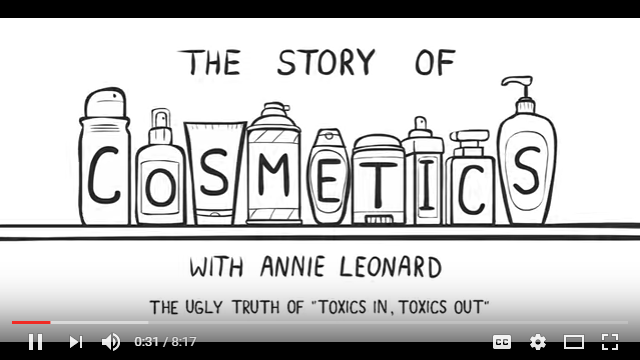
Why Is the Fragrance Industry Against Safety Regulations?
Like the secret formula for Coca-Cola and Colonel Sander’s secret recipe for Kentucky Fried Chicken, the fragrance industry has been guarding its carefully kept secrets for decades. As such, a certain air of mystery has resulted. Says fragrance consultant Steve Herman:16
“The perfume industry has been trying to maintain a certain mystique, because fragrance has an allure of mystery, romance and creativity about it. If we transform it into a chemical company with ingredient disclosure — all of that mystique would be gone.”
Whelan suggests the huge number of chemicals needing to be tested is very likely the most discouraging factor related to safeguarding consumer products:17
“There are over 80,000 chemicals in use today. While most of them are probably safe, it takes time and money to test them. Industry doesn’t want to know which are harmful because it would mean reformulating many of their products, which would require additional money.
Furthermore, by disclosing chemicals on the label, particularly if one is a potential carcinogen, companies could be liable, which they also do not want. Industry wants it both ways. They don’t want chemicals proven safe, and they don’t want consumers to have full disclosure.”
Because the U.S. federal government has traditionally taken a passive role in terms of regulating the addition of chemicals in consumer products, individual states, such as California, have taken action on their own. California’s well known Proposition 65, or Prop 65,18 was enacted in 1986. Eleanne van Vliet, director of toxic chemical research for As You Sow, sees value in state-enacted regulations:19
“Prop 65 prohibits businesses from knowingly exposing consumers to chemicals known to cause cancer or birth defects. Companies have to either reformulate the product to use less toxic ingredients or remove the product from the market completely.”
EWG Helps You Identify Toxic Ingredients You Should Avoid
Judi Shils, executive director of Teens Turning Green, underscores the importance of taking an active role in evaluating the personal-care products you use every day.20 “Shampoo, conditioner, deodorant, toothpaste, moisturizer, hand sanitizer — each one of those products has about 15 synthetic chemicals in it, so your body’s burden is enormous. You’re just dumping all this toxic stuff into your bloodstream!”
To help you identify harmful ingredients and make buying choices that support your health and well-being, the EWG provided the following list of toxins to AVOID in personal-care products manufactured for the U.S. market:21
For your body:
|
For your hair:
|
For your nails:
|
If you want to go further in your exploration of potentially harmful ingredients, check out EWG’s Skin Deep® database,22 where you can research the personal care products you use and identify less toxic options. EWG also maintains a Guide to Healthy Cleaning,23 which informs you about safe alternatives for household-cleaning products.
Non-Toxic Fragrances Are Available
Avoiding toxic fragrance does not mean that you must forgo all pleasant scents in your home or personal-care products, because truly natural options are available. Organic essential oils are one option, and you can even add them to your own non-fragranced products, such as facial moisturizers or hand lotion. Organic essential oils and isolates come from botanical ingredients such as bark, flowers, fruits, leaves, seeds, wood and other 100 percent natural raw materials.
Though they may cost more, and the scent may last only a couple of hours after each application, organic essential oils won’t pose the health risks of synthetic fragrances. (It’s still possible to have sensitivities to natural scents so take care with them around individuals who may not be able to tolerate them.)
Of course, you have the option of avoiding fragrance entirely. In fact, a woman’s natural scent has been found to be more seductive than perfume,24 scoring another point for the power of nature!
LCSA Law Implemented, EPA Finally Empowered to Review Chemicals
In June, 2016, U.S. Congress overwhelmingly passed the Frank R. Lautenberg Chemical Safety for the 21st Century Act (LCSA) to reform TSCA. Although the changes will likely be slow, LCSA introduces improvements such as:25
- Mandating the EPA to evaluate existing chemicals under enforceable deadlines
- Requiring all chemicals used in commerce to undergo risk-based reviews
- Providing increased public transparency with respect to chemicals
- Funding the EPA consistently so it can carry out its responsibilities under the new law
On the downside, the LCSA makes it more difficult for states to regulate chemicals once the EPA has evaluated them, and prohibits states from taking action against any chemical the EPA has declared “high priority” for EPA investigation. Once the EPA declares a chemical safe for a specific use or condition, states are permanently preempted from taking any action against it.26
In December 2016, the EPA announced the first 10 chemicals it will review under LCSA, as highlighted by the EWG:27 1,4-dioxane, 1-bromopropane, asbestos, carbon tetrachloride, HBCD (cyclic aliphatic bromide cluster), methylene chloride, NMP (n-methylpyrrolidone), PERC (tetrachloroethylene), pigment violet 29 and TCE (trichloroethylene). Several of the 10 are suspected to be possible human carcinogens.
While you may think asbestos was banned many years ago, the U.S. still imports, uses and sells asbestos and asbestos products for use in automotive, flooring and roofing products, even though inhalation or ingestion of asbestos fibers is known to cause lung cancer. Clearly, the EPA has a lot more work to do to safeguard your health and mine.
What You Can Do to Help Close the ‘Fragrance Loophole’
Based on feedback from consumers like you, and the diligence of consumer-advocacy organizations like EWG, manufacturers and retailers are beginning to realize the need for change. U.S.-based companies such as Procter & Gamble (P&G),28 S.C. Johnson29and Unilever,30 as well as retailers like Target31 have taken steps to become more transparent with ingredient lists.
Some steps are small, such as P&G’s move to provide two lists on its website32 of fragrance chemicals the company is currently using, and those no longer in use in any of its brands. While that sounds positive, P&G still has access to more than 2,800 other fragrance chemicals that would not have to be disclosed on product labels.
Other steps are bigger, such as Target’s decision33 to require full ingredient disclosure by 2020 for all baby care, household and personal care products, as well as a ban on formaldehyde, parabens and phthalates in those products. Furthermore, by 2022, Target wants to remove flame retardants and perfluorinated chemicals from all its textiles.
If you want to go to the next level with respect to taking a stand against the continued use and abuse of fragrance in consumer products, below are some tips on how you can get started:34
| Choose products that disclose a complete list of ingredients |
| Select “fragrance free” products instead of “unscented” ones because unscented products may use fragrance to mask odors |
| Be wary of “greenwashing” related to the use of terms such as “natural” or “organic” for personal care products because they are unregulated and can be used regardless of product contents |
| Research the product’s ingredients prior to purchase by perusing the EWG’s Skin Deep database and/or other sources35 |
| Opt for products using organic essential oils instead of synthetic scents |
| Educate your children and make them aware of safer choices for the products they use daily |
| Ask the company for specific details about the products you like and find out if they are safe |
| Vote with your dollars and stop buying products that you know are unsafe |
| Demand action by telling manufacturers and retailers, as well as your state and federal legislators, that you support the full disclosure of ingredients for household and personal-care products and want safer alternatives |
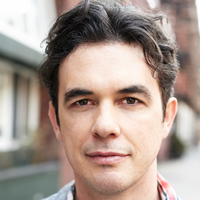 About the Director Jon Whelan is the director of “Stink!” — an off-beat documentary about Whelan’s tenacious quest to uncover the source of a chemical scent in a pair of his daughter’s pajamas. Like most Americans, Whelan believed that if a product was on the store shelf then it must be safe. Through his investigation, Whelan discovers a culture of secrecy surrounding carcinogens in everyday consumer products that begins in corporate board rooms and extends all the way to the halls of Congress. A former co-CEO of Afternic.com, an internet/media start-up adviser and a founding member of the New York Angels, Whelan currently advocates for truthful product labeling and is a full-time parent of two young daughters. We sat down with Jon to learn a little more about what goes in to making these films. Thank you to Jon for sharing with us. What was your inspiration for making this film? I was inspired, personally, by my wife and daughters (you’ll need to watch the film to see why). Professionally, I was motivated to find out how it’s possible that companies in America are allowed to use harmful chemicals in everyday consumer products and not disclose it to their customers. As my grandmother used to tell me, “The truth is stranger than fiction.” What was your favorite part of making this film? Learning how the “system” works (or in this case doesn’t work) and connecting the dots. Once you know, you look at things through a different lens, and then you’re left with two choices: Help fix what’s broken or live with the status quo. I’m an optimist and I think that this is a solvable problem. Where do the proceeds to your film go? “Stink!” is a passion project. I definitely couldn’t justify four years of my life and spend a fortune on bringing this project to fruition if profit were the motive. Individuals can stream “Stink!” free at StinkMovie.com or host a free screening. I hope people take advantage of the offer. 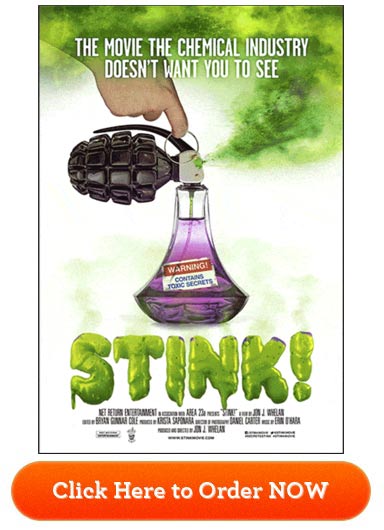 |
————————————————————————————
City of burning lakes: experts fear Bangalore will be uninhabitable by 2025
The illegal dumping of waste mixed with mass untreated sewage in India’s Silicon Valley is creating a water crisis which threatens residents’ health – and is causing the city’s famous lakes to catch fire

Bellandur lake, the city’s largest body of water covered in a thick layer of vegetation, burned for hours on the evening of 16 February 2017. Photograph: Aaditya Sood
On the evening of Thursday 16 February, residents in the south-east part of Bangalore noticed huge plumes of smoke rising into the sky. The smoke was coming from the middle of Bellandur Lake – the biggest lake in the city at a little over 890 acres. They realised the seemingly impossible had happened: the lake had caught fire. Even fire fighters wondered how a blaze in water could be put out.
The fire in the lake burned for 12 hours and left behind a sinister black patch in the centre, according to some eye-witness accounts.
This is the new story of Bangalore – state capital, India’s Silicon Valley, and once upon a time, the “city of lakes”. The reasons why these lakes are able to catch fire begin to explain why scientists at the influential Indian Institute of Science believe Bangalore will be “unliveable” in a few years’ time.
A lethal mix of factors create an environment that merely requires the slightest of triggers for lakes to go up in flames. Untreated effluents pour into the waters from the many industries and homes on its banks, illegal waste disposal takes place on a large scale – often including rubbish which is set on fire – and invasive weeds cover large swathes of the lake in a thick green canopy.
The latest incident is not the first time the lake has caught fire; it happened in May 2015. A few days later, it was in the news again for being covered in snow-like froth, which began to swirl up in the summer wind, engulfing passers-by. The froth was the result of chemical waste dumped in the lake, and was toxic enough to crack windshields, wear the paint off car hoods and exacerbate the severe respiratory issues that have plagued citizens in recent years.
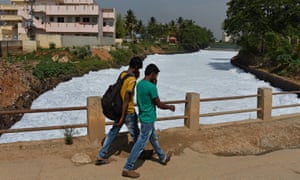
Dr TV Ramachandra, coordinator of the Energy and Wetlands Research Group at the Indian Institute of Science (IISc), has been studying the lakes in Bangalore, especially Bellandur and Varthur, for over two decades. He explains that an estimated 400-600 million litres of untreated sewage is let into the lake catchment every day, creating a toxic environment fertile for disasters like the fires and foam.
“The city overall generates between 1,400 and 1,600m litres per day of untreated sewage,” he says. “20-30m litres per day is generated from the apartments in the vicinity of Bellandur Lake. There are several invasive species like water hyacinths growing in the lake, thick enough to walk on. People dump solid waste on top of it. Because of the thickness, it creates an anaerobic environment in the water below, where methane is formed. It creates an ideal environment for catching fire.”
He believes there are too many agencies governing the lake, so they all blame each other for such incidents. “The Bangalore water supply and sewerage board should be held responsible for letting the untreated sewage into the water,” he says, adding that the onus should also be placed on the Karnataka state pollution control board for not regulating industries that have been draining their untreated sewage into the lake.
Although the Water (Prevention and Control of Pollution) Act and The Air (Prevention and Control of Pollution) Act require action to be taken over such matters, the government has mostly remained silent, while its departments have been passing the buck around. The National Green Tribunal has issued notices to all the agencies involved.
Long before it began its slow and painful death, Bellandur Lake was part of a clever water and irrigation system devised by the founders of Bangalore in the 1600s, giving it the “city of lakes” moniker. The streams formed at the top of surrounding valleys were dammed into man-made lakes by constructing bunds. Each of these lakes would harvest rainwater from its catchments and the surplus would flow downstream, spilling into the next lake in the cascade via storm water drains or raja kaluves. The bodies of water would in turn serve the needs of the population.
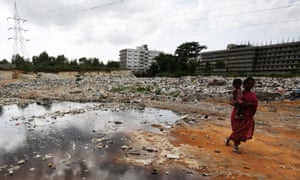
In the 1970s, there were still 285 lakes in the city, making it self-sufficient in its water needs. Today, however, there are just 194 lakes, and the large majority of them are sewage-fed. The rest have been lost to encroachments – by the Bangalore Development Authority, private real estate developers and illegal builders – to cater to the booming housing needs of a city of 10 million.
According to studies by the IISc, rapid urbanisation and expansion between 1973 and 2016 caused a 1005% increase in paved surfaces and decline of 88% in the city’s vegetation, while water bodies declined by 85% between 2000 and 2014.
The rise of the IT sector has also created the problem of e-waste in the city: a 2013 report estimated that Bangalore produces 20,000 tonnes of e-waste per year. Although a formal recycling system for e-waste was set up, 90% of it is dealt with through the informal sector, which is harder to monitor. Unaware of the necessary safety measures, some incinerate the e-waste, releasing lead, mercury and other toxins into the air – and dump the rest, allowing pollutants to infiltrate the groundwater.

If one lake habitually catches fire, then another throws up thousands of dead fish every other summer. Ulsoor Lake, which doubles up as a picnic spot with boat rides and snack vendors on its banks, saw dead fish floating on its waters last year owing to the pollution caused by untreated sewage and consequent depletion of dissolved oxygen.
The water pollution in Bangalore poses a serious threat to residents’ health and creates a chronic shortage of clean water for people to use. All in all, experts predict a severe water crisis which will make Bangalore uninhabitable by 2025, with residents potentially having to be evacuated.
In the aftermath of the latest fire, I spoke to Aaditya Sood, an IT professional who watched the flames from his 10th floor balcony. He said he had seen the lake being “choked” in the seven or eight years he has lived there. “I have two kids and respiratory issues are a problem,” he says. The toxins from the lake get into the air, according to Ramachandra, noting that the cases of lung-related medical conditions have increased drastically in the city recently.
Another resident, Vandana Sinha, who works for a consultancy firm, says the smoke from the fire almost immediately caused itchiness at the base of her throat. She had heard that seven to eight trucks worth of garbage was being dumped into the lake every night, adding to the lethal combination of pollutants in the waters.
Report after report by expert committees have recommended several short and long term measures for rescuing the city’s lakes. Stopping the dumping of garbage, treating sewage water before it is allowed into the lakes, checking encroachments and slowing the development agenda are top of the list.
In the next three years, if the same rate of development continues, the built up area in Bangalore is expected to increase from 77% to 93%, with a vegetation cover of a mere 3%. Ramachandra is determined to get the bureaucracy to act before it is too late. While the city may not fully cease to exist, without drastic improvement the other possibilities still sound impossibly grim.
Follow Guardian Cities on Twitter and Facebook to join the discussion, and explore our archive here
————————————————————————————
————————————————————————————
————————————————————————————
————————————————————————————


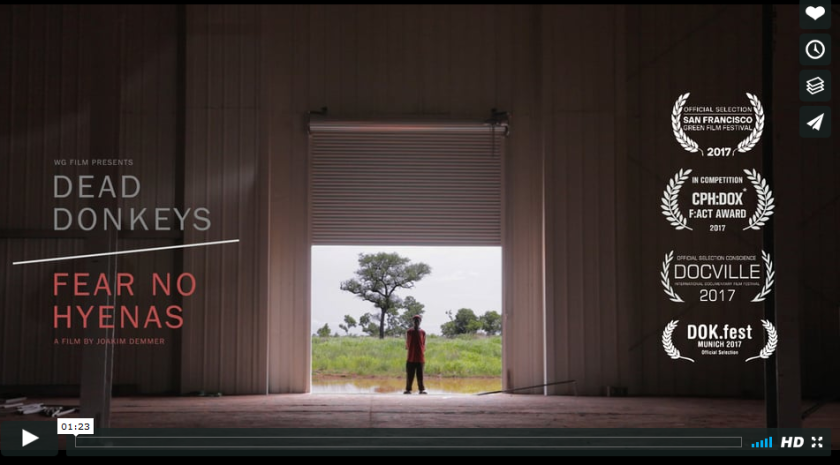



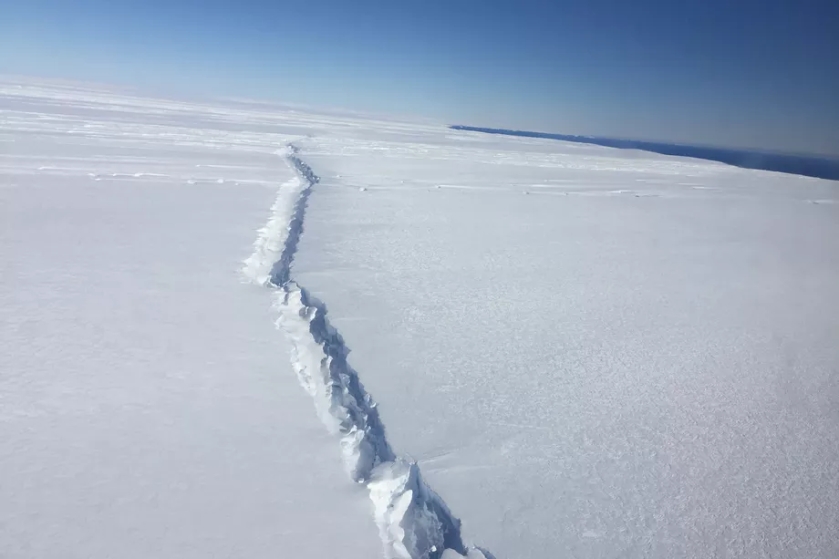
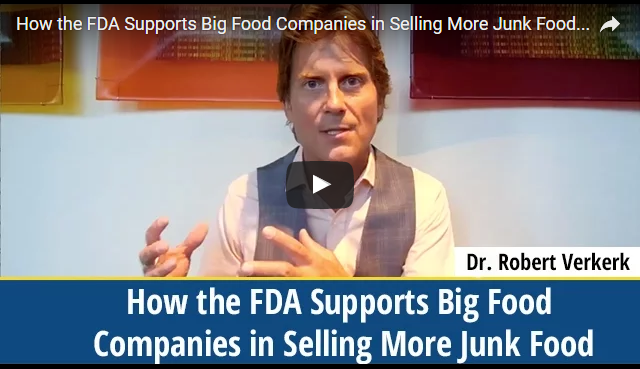
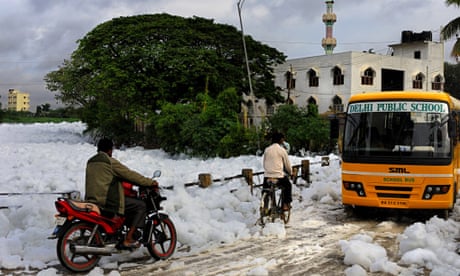
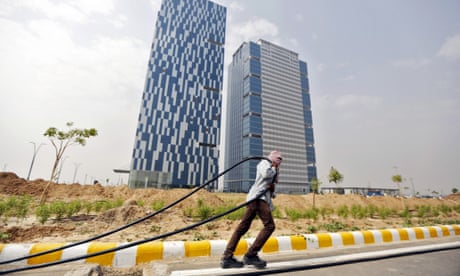
6 thoughts on “News. Terrifying.”